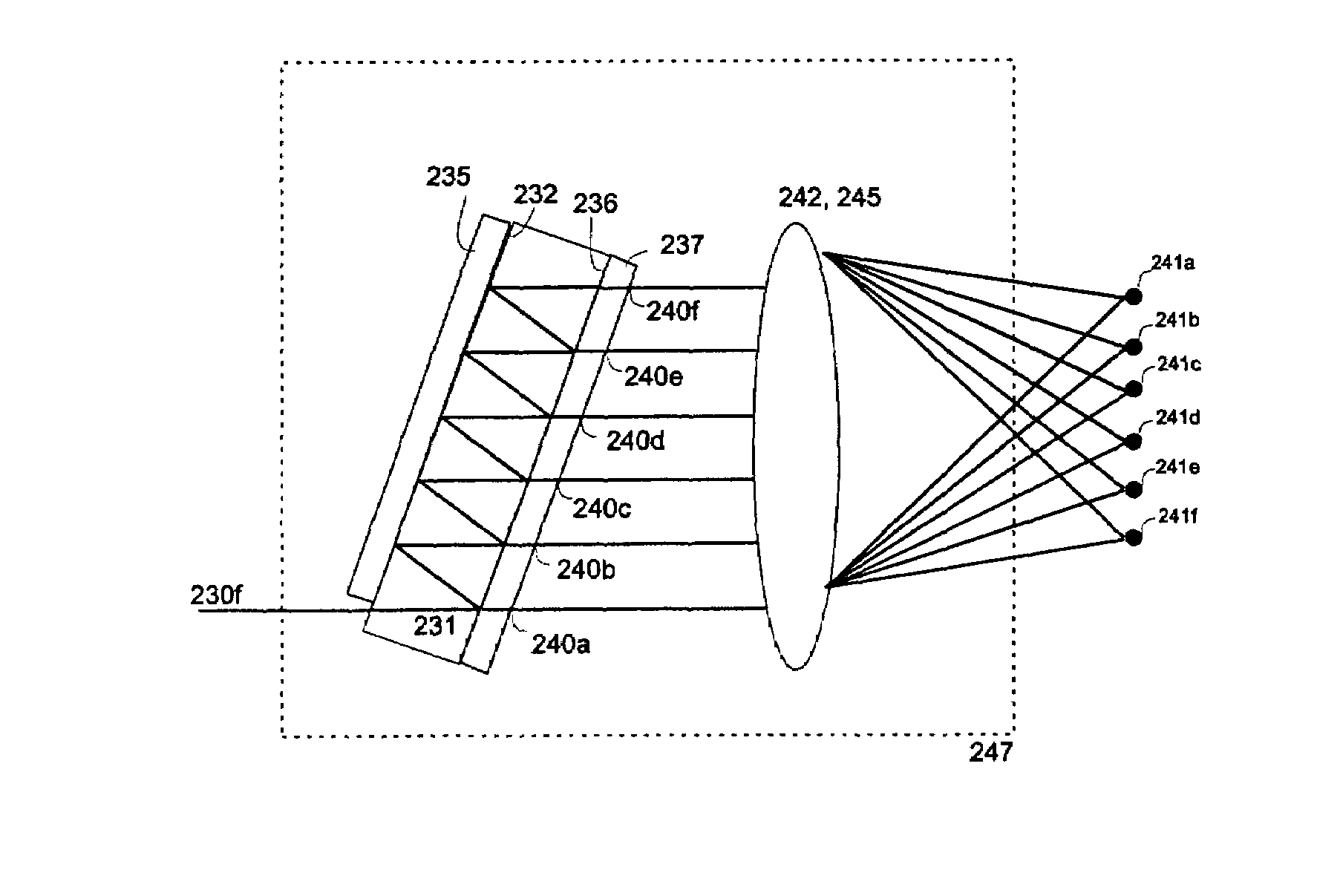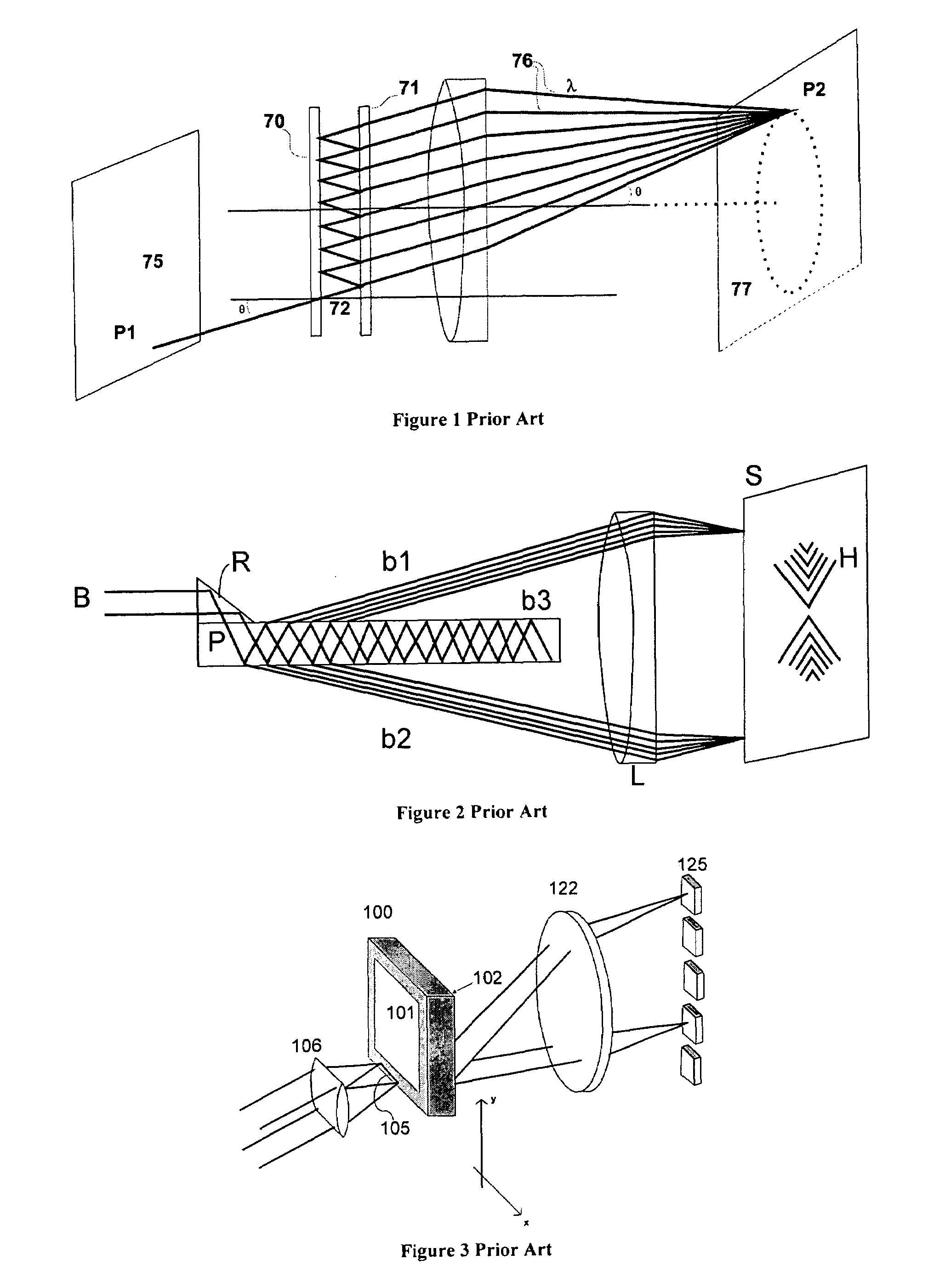The relatively high cost of installing new fiber optic cable presents a barrier to increased
carrying capacity, however, so it is highly desirable to increase the data carrying capabilities of existing fiber.
The Fabry-Perot interferometer is not well suited for use as a WDM channelizer due to the difficulty in obtaining high optical
throughput efficiency.
It is difficult to collect this light efficiently and concentrate it at multiple
detector points, or couple it to multiple output fibers, especially while maintaining the separation of wavelength components that the interferometer has produced.
This fanning makes it easy to concentrate the output light at multiple
detector points or fibers, but there is inherently high loss.
However, the absence of a
surface coating means that it is not possible to tailor the fringe intensity profile.
This makes the Lummer-Gehrcke interferometer impractical for use in WDM applications in which the fringe profile controls the
channel filter shape.
The Lummer-Gehrcke interferometer also is not well suited for use as a WDM channelizer due to the difficulty in obtaining high optical
throughput efficiency.
It is difficult to collect this light efficiently and concentrate it at multiple
detector points, or couple it to multiple output fibers, especially while maintaining the separation of wavelength components that the interferometer has produced.
Again, it is difficult to collect this light efficiently, and there is generally an inherent loss.
The exiting beams interfere with each other.
This overlap effect makes weighting the individual virtual sources possible only in an area-average sense, thus limiting the degree to which the
channel filter shape can be tailored.
However, the line-focused input makes the VIPA impractical for fine channelization (i.e.,
narrow channel spacing on the order of one GHz) due to the fact that a thicker plate is needed, which would result in excessive
beam divergence and overlap at the
exit surface.
Since the interference filters produced by thin film coatings tend to have relatively wide passbands, they cannot achieve
high resolution (twenty-five GHz or finer).
In addition, stacking thin-film filters such as the device in U.S. Pat. No. 6,111,474 produces loss that effectively limits the number of channels.
Diffraction gratings of reasonable size do not have sufficient resolution for HWDM.
They also have high optical
insertion loss, making them inefficient for use in high-resolution WDM systems.
Diffraction gratings tend to produce undesirable polarization effects.
It is difficult to achieve resolution better than fifty GHz using an AWG.
AWG devices capable of one GHz resolution would be physically large, expensive, and have very high loss.
It is important to use one
grating per wavelength channel, so there is an inherent limitation on the number of channels that can be de-multiplexed with such devices due to the shear bulk of the resulting
system.
These operations also require inflexible devices that are costly and difficult to
upgrade as
system capacity demand is increased.
Second, OADMs require smaller packaging because removing the electrical conversion step results in a reduced component count within the switches.
Although such filters have good
channel isolation, they tend to exhibit a transmission light loss of approximately 10%.
Such filters are also highly temperature-sensitive.
Further, they often operate in only one direction.
In addition, such filters are limited to a single, fixed wavelength.
This results in increased complexity, optical loss, and cost.
The device illustrated in FIG. 6 is limited in that it can add / drop only a single wavelength.
This results in increased complexity and cost.
The result can be a very large device with a high component count, increased complexity, and a higher cost.
In addition, the combination or cascading of multiple-fiber Bragg gratings can significantly reduce
signal strength as the
insertion loss of multiple devices is compounded throughout the
system.
However, this technique is subject to very high optical component count.
Assembling and aligning these optical components within a device can be extremely expensive.
This ability is important because the optical to electrical to optical conversion process is expensive and uses significant power as well as space.
However, it is only possible to interact with a single wavelength at one time using this technique.
However, this system can only accommodate adding or dropping a single channel simultaneously.
But in practice, due to the need to maintain low cross-correlation properties between the
high rate sequences, the number of
usable sequences, hence users, is somewhat less than the processing
gain.
The main problem with fiber optic systems is the inefficient nature of dedicated
bandwidth allocation architectures.
Many communications, particularly
Internet Protocol communications, are extremely bursty.
This may not be feasible.
However, detection of bi-polar codes requires detection in the presence of an unmodulated
reference beam, i.e., coherent detection.
Coherent detection is difficult and expensive to achieve in a practical system.
The Dutt system is not very optically efficient due to the use of unipolar codes and it has a limited code set.
The Pfeiffer systems are more efficient but also have a limited code set resulting in a limited number of users.
This multi-stage system is complex to build and relies on two fiber Bragg gratings.
This is less optically efficient than using a single grating.
The number of frequency bands, and hence, the number of available codes, and therefore users, is limited in a practical system.
In summary, the existing methods of OCDMA are not very efficient which yields a lower number of potential users.
Furthermore, they rely upon grating technologies that have limited resolution.
Lastly, some of the more efficient methods are complex and costly to manufacture.
In particular, maintaining increasingly narrower
channel spacing demands extreme precision in the frequency stability from the source
laser—a precision that is not reliably achievable.
Factors such as equipment aging, device tolerances, power source fluctuations, and temperature changes all serve to complicate the problem.
The likely result is that the frequency of interest “drifts” relative to the target or detector with a corresponding degradation of the signal.
These devices vary in size, complexity and cost.
The Fabry Perot etalon does not serve well as a WDM channelizer due to the difficulty in obtaining high optical
throughput efficiency.
It is difficult to collect this light efficiently and concentrate it at multiple detector points, or couple it to multiple output fibers, especially while maintaining the separation of wavelength components that the etalon has produced.
This fanning makes it easy to concentrate the output light at multiple detector points or fibers, but there is inherently high loss.
It is currently impossible to obtain such a filter in practice, but the more closely a device approximates this ideal the better its
signal processing capability becomes.
Grating-based technologies are effectively limited to 50 GHz resolution.
It is apparent from FIG. 9 that the prior art interleaver architecture is relatively complex and requires multiple devices, which introduces undesirable power losses into the system and increases device size and costs.
Although this can be accomplished, the size of the
diffraction gratings and the expense of making such a large device creates a practical limit on the resolution of
diffraction-grating based OSAs at 30 to 50 picometers.
One trend in this direction is decreasing the spacing between wavelengths to 25 GHz, 12.5 GHz and less However, as
channel spacing decreases common WDM network problems such as
transmitter wavelength drift, filter
concatenation, and signal
distortion can more easily cause cross-talk between these closely-spaced channels.
However, current WDM integrated optic technologies suffer from the same
channel spacing and resolution limitations as their bulk optic counterparts.
Although integrated
optical diffraction grating-based devices, such as the aforementioned examples, are being used in WDM systems, their resolution is limited.
An IO WDM device with a
diffraction grating and an AWG would need to be very large and expensive to have sub-50 GHz channel resolution, and would suffer from very high loss.
However, this device cannot produce the
narrow channel spacing and high channel counts of an OTDL-based integrated optical
demultiplexer.
However, the fabrication of this IO
demultiplexer could be extremely difficult and expensive due the precision required in the thin film
deposition process to lay down the
prism and lens
layers, as well as the nature of the stack materials.
The drawback to this type of integrated optical WDM
demultiplexer /
multiplexer is the inherently high loss associated with the thin film wavelength-separation elements, which limits the number of channels that can be effectively demultiplexed, as well as the level of channel spacing within a DWDM system.
Such a method of construction could be very labor intensive and expensive as each optical component and sub-system must be aligned and fixed in place.
Maintaining important fabrication and functional tolerances can be difficult.
 Login to View More
Login to View More  Login to View More
Login to View More 


